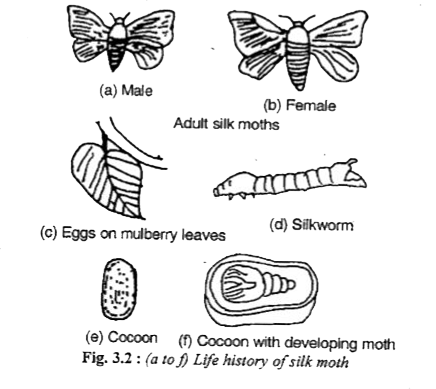Discuss in detail the life history of silk moth.
Text Solution
Life history of silk moth : The female silk moth lays eggs, from which hatch larvae which are called caterpillars or silkworms. They grow in size and when the caterpillar is ready to enter the next stage of its life history called pupa, it first weaves a net to hold itself. Then it swings its head from side to side in the form of the figure of eight (8). During these movements of the head, the caterpillar secretes fibre made of a protein which hardens on exposure to air and becomes silk fibre. Soon the caterpillar completely covers itself by silk fibres. This covering is known as cocoon. The further development of the moth continues inside the cocoon (Fig. 3.2). Silk fibres are used for weaving silk cloth. The soft silk yarn is as strong as a comparable thread of steel.

The silk yarn (thread) is obtained from the cocoon of the silk moth. There is a variety of silk moths which look very different from one another and the silk yarn they yield is different in texture (coarse, smooth, shiny, etc.). Thus, tassar silk, mooga şilk, kosa silk, etc., are obtained from cocoons spun by different types of moths. The most common silk moth is the mulberry silk moth. The silk fibre from the cocoon of this moth is soft, lustrous and elastic and can be dyed in beautiful colours.
|
Updated on:21/07/2023
Similar Questions
Knowledge Check
- Question 1 - Select One
The eggs of silk moth are
AHomolecithalBTelolecithalCMesolecithalDCentrolecithal - Question 2 - Select One
Which stage in the life cycle of silk moth secretes silk ?
ACaterpillarBEggCPupaDAdult - Question 3 - Select One
Which stage of silkworm secretes silk ?
ACaterpillarBEggCPupaDAdult
Name the species used in sericulture. Name the stages in the life cycle of a silk moth in cyclic form.
View SolutionLife History Variation
View SolutionSilk |Sericulture|Life History Of Silk Moth|From Cocoon To Silk|Types Of Silk|OMR
View SolutionMetamorphosis in the life history of Periplaneta is
View SolutionThe history of life shows that :
View Solution

